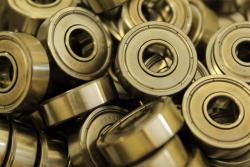Radial and thrust forces in bearings
11 Oct,2018
Where accuracy is required, it is important for engineers to consider the forces acting on a bearing. Because a bearing typically supports the free motion of a shaft about an axis of rotation, two forces normally act on the bearing: a radial load and a thrust load. But, what is the impact of these forces? Here, Chris Johnson, managing director of SMB Bearings, explains.

A radial load acts perpendicular, at 90 degrees, to the axis of rotation, while a thrust load — also known as an axial load — acts in parallel to the axis of rotation. Any misalignment of the shaft can also result in a moment load, a tilting force that can increase wear.
Applying a thrust load to a bearing can be beneficial. For example, applying a permanent thrust load (preload) to the inner or outer ring, using washers or springs, can eliminate play in the bearing and provide more accurate rotation. Conversely, applying an excessive load can be catastrophic. If engineers fail to adequately match a bearing to the radial and thrust loads in an application, it can drastically reduce the life of the bearing.
When calculating bearing life, it is important to consider load ratings, these are a measure of how quickly the rotating elements of a bearing will experience fatigue and the total number of revolutions a bearing can withstand before it fails. These ratings can be categorised into static load ratings and dynamic load ratings.
A typical radial ball bearing, which is designed primarily for radial loads, has a maximum static and dynamic load capacity. The static load capacity is the maximum radial load that a bearing can withstand before the load causes a total, permanent deformation of the bearing balls or the raceway equal to one ten-thousandth of the ball's diameter.
Although a bearing may be able to tolerate a high static load, it will do so at the loss of accuracy and smoothness, making it impractical for use in high accuracy environments, such as electronics manufacturing and in robots used in food and beverage production. The typical static-load rating for a stainless steel bearing is approximately 75–80% of the load rating for chrome-steel bearings, due to the hardness of the material.
The dynamic load rating, on the other hand, is the ability of 90% of a group of identical chrome-steel bearings, with only the inner ring rotating, to endure a radial load of a constant magnitude and size for one million revolutions before the first signs of fatigue develop.
The greater the load, the higher the level of stresses the balls and raceways will be subjected to. This will lead to more rapid wear and a shorter bearing life. Fatigue failure results in the ball path being eroded, leading to spalling, where a fracture on the surface of the raceway causes material to be removed, ultimately leading to failure.
Excessive loading can also lead to other signs of fatigue such as overheating, degradation of the lubricant and abrasion caused by flakes of particulate matter.
Choosing the right bearing
There are a variety of measures that manufacturers can take to ensure long bearing life. The first step is to limit the radial load to between 6–12% of a bearing's dynamic load rating. Although a bearing is able to tolerate a much higher load, its life will be shortened.
The next step is to choose the right material. In SMB Bearings' experience as a specialist in thin-section, corrosion resistant and miniature bearings, choosing the right type of bearing can also make all the difference. While all radial ball bearings have some thrust load capacity, it's often better to use heavy duty bearings that have deep raceways if greater thrust loads are present as these can withstand axial loads of up to 50% of the static radial load rating.
Although thin-section bearings — where the difference between the inner and outer diameter of the bearing is small — are great for compactness and saving weight, they can only support axial loads of between 10 and 30% of the bearing's static radial load rating due to the shallower raceways. Additional radial loads or moment loads will reduce thrust load capacity even further. Excessive thrust loads on a thin-section bearing can cause the balls to ride dangerously close to the top of the raceway.
By choosing the right type of bearing and considering key factors in the battle to control radial and thrust loads, engineers can ensure they continue to innovate while delivering the highest levels of accuracy, smoothness and bearing life.
